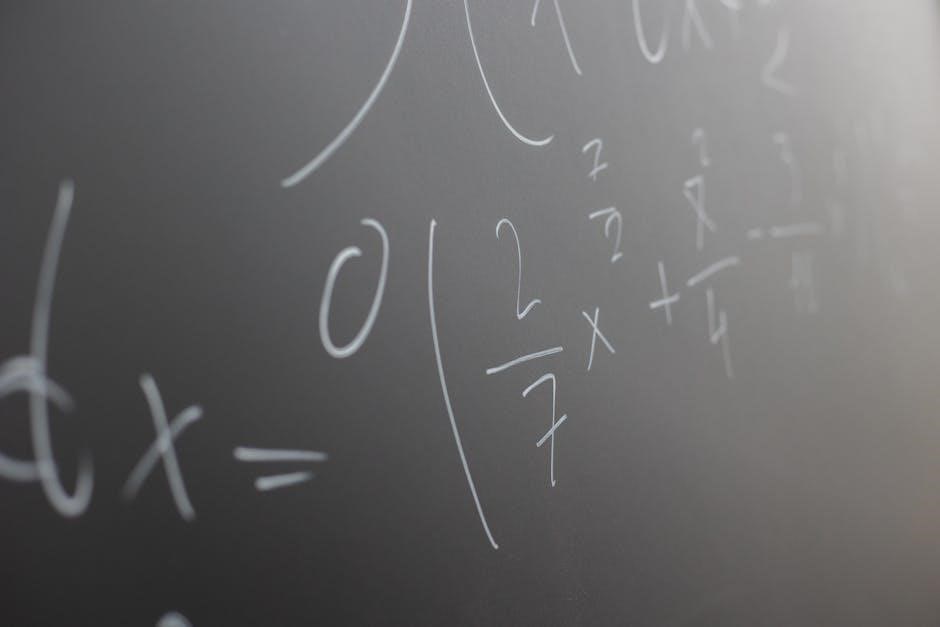Welcome to the Algebra 1 Study Guide‚ your comprehensive resource for mastering foundational algebra skills. This guide provides detailed explanations‚ practice problems‚ and strategies to ensure success in algebra.
1.1 Importance of Using an Algebra 1 Study Guide
An Algebra 1 study guide is essential for building a strong foundation in algebra. It provides structured review‚ practice problems‚ and explanations to enhance understanding. By focusing on key topics like equations‚ functions‚ and word problems‚ students can identify weaknesses and improve skills. Regular use of a study guide boosts confidence‚ problem-solving abilities‚ and preparation for exams.

Key Topics Covered in the Study Guide
This guide covers essential Algebra 1 topics‚ including rational expressions‚ integers‚ order of operations‚ prime numbers‚ and factoring‚ providing a solid foundation for algebraic problem-solving.
2.1 Rational Expressions and Equations
Rational expressions and equations involve fractions with variables in the denominator. Mastering these requires factoring‚ simplifying‚ and solving equations by clearing denominators. Skills include multiplying‚ dividing‚ and adding/subtracting rational expressions using LCDs. These concepts are fundamental for solving real-world problems and advancing in algebraic manipulations‚ ensuring a strong mathematical foundation for higher-level topics.
2.2 Operations with Integers
Operations with integers involve addition‚ subtraction‚ multiplication‚ and division of whole numbers‚ including positives‚ negatives‚ and zeros. Understanding the rules for signs is crucial: positive + positive = positive‚ negative + negative = negative‚ and opposites cancel out. These foundational skills are essential for solving equations‚ simplifying expressions‚ and advancing in algebraic manipulations.
2.3 Understanding Order of Operations
The order of operations‚ often abbreviated as PEMDAS‚ guides how to solve expressions step-by-step: Parentheses first‚ followed by Exponents‚ then Multiplication and Division‚ and finally Addition and Subtraction. This rule ensures consistency and accuracy in simplifying expressions and solving equations‚ preventing errors in mathematical calculations.
2.4 Prime Numbers and Factoring
Prime numbers are integers greater than 1 that have no positive divisors other than 1 and themselves. Factoring involves breaking down expressions or numbers into products of simpler terms. Key methods include finding the greatest common factor‚ factoring by grouping‚ and using formulas for special products like the difference of squares.

Effective Study Strategies for Algebra 1
Engage in active learning by solving practice problems regularly‚ using visual aids to understand concepts‚ and breaking down complex topics into manageable parts.
3.1 How to Approach Practice Problems
Start by reading problems carefully and identifying key terms. Break down complex questions into simpler steps‚ using prior knowledge to guide your approach. Always show your work and check solutions to ensure accuracy. Review mistakes to understand common errors and improve problem-solving skills over time.
3.2 Utilizing Visual Aids and Graphs
Visual aids like graphs and charts are essential for understanding algebraic relationships. Use line graphs to plot linear equations and parabolas for quadratics. Diagrams can simplify word problems‚ while charts help organize data. Incorporate sketching and labeling to enhance comprehension and retention of key concepts. These tools make abstract ideas more tangible and easier to analyze.
Solving Equations and Inequalities
Mastering equations and inequalities is fundamental in Algebra 1. This section covers solving linear and quadratic equations‚ simplifying expressions‚ and applying properties like the distributive property. Learn to isolate variables‚ handle inequalities with care‚ and understand when to reverse the inequality sign. Practice problem-solving techniques and step-by-step solutions to build confidence and accuracy.
4.1 Linear Equations and Their Solutions
Linear equations involve variables of degree one and are fundamental in algebra. To solve them‚ isolate the variable using inverse operations‚ such as addition‚ subtraction‚ multiplication‚ or division. Combine like terms and simplify expressions to find the value of the variable. Practice solving equations with integers‚ fractions‚ and decimals to master linear equations. Resources like study guides provide step-by-step solutions and examples for better understanding.
4.2 Solving Inequalities Step-by-Step
Solving inequalities involves similar steps to solving equations but with one key difference: multiplying or dividing by a negative number reverses the inequality sign. Start by simplifying both sides‚ then isolate the variable using inverse operations. When graphing solutions‚ use an open circle for “less than” or “greater than” and a closed circle for “less than or equal to” or “greater than or equal to.” Practice examples in study guides help master these concepts and avoid common mistakes.

Graphing Linear Equations
Graphing linear equations involves understanding slope and intercept. Identify the slope and y-intercept from the equation‚ plot the intercept‚ and use the slope to mark additional points. Connect these points to form the line‚ ensuring accuracy. This method is covered in detail in study guides to help visualize and interpret linear relationships effectively.
5.1 Understanding Slope and Intercept
Understanding slope and intercept is essential for graphing linear equations. The slope (m) determines the steepness and direction of the line‚ while the y-intercept (b) is where the line crosses the y-axis. Identify these values from the equation y = mx + b. Plot the intercept‚ then use the slope to mark additional points. This method helps in accurately visualizing and interpreting linear relationships in algebra.
5.2 Plotting Points and Drawing Lines
Plotting points accurately on a coordinate plane is the first step in graphing linear equations. Identify the x and y coordinates for each point and mark them precisely. Once points are plotted‚ use the slope to determine the line’s direction. Connect the points smoothly to form the line‚ ensuring it extends correctly in both directions. This process helps visualize relationships between variables in algebraic equations.
Quadratic Equations and Functions
Quadratic equations and functions involve solving expressions with squared variables. Learn to graph parabolas‚ identify vertices‚ and apply the quadratic formula for real-world problem-solving in algebra.
6.1 Solving Quadratic Equations
Quadratic equations are solved using factoring‚ completing the square‚ or the quadratic formula. These methods help find the roots of equations like ( ax^2 + bx + c = 0 ). Graphing parabolas and identifying key features‚ such as the vertex‚ are also essential skills. Practice problems and real-world applications reinforce understanding of quadratic functions and their solutions.
6.2 Graphing Parabolas
Graphing parabolas involves identifying the vertex‚ direction‚ and axis of symmetry. The vertex form of a quadratic equation (y = a(x-h)^2 + k) helps determine the vertex (h‚ k) and whether the parabola opens upward or downward. Plotting additional points and identifying key features‚ such as the y-intercept and x-intercepts (roots)‚ enhances understanding of quadratic functions and their graphs.

Functions and Their Properties
Functions relate inputs to outputs‚ ensuring each input has one output. Key properties include domain‚ range‚ and inverse functions‚ essential for understanding relationships and modeling real-world scenarios;
7.1 Domain and Range of Functions
The domain of a function is the set of all possible input values (x-values)‚ while the range is the set of all possible output values (y-values). Understanding domain and range is crucial for defining the behavior of functions. They determine the limitations and possible outcomes when graphing or solving equations. These concepts are essential for analyzing function properties and real-world applications.
7.2 Inverse Functions Explained
Inverse functions are pairs of functions that reverse each other’s operations. To find the inverse‚ switch the roles of x and y‚ then solve for y. For example‚ if ( f(x) = 2x + 3 )‚ the inverse ( f^{-1}(x) = rac{x ‒ 3}{2} ). Inverse functions are essential for solving equations and understanding function relationships. They are graphically represented as reflections over the line ( y = x ).

Practice Problems and Solutions
Practice problems and solutions are essential for mastering Algebra 1. This section provides multiple-choice and free-response questions with detailed solutions‚ helping students improve problem-solving skills and understand key concepts.
8.1 Multiple-Choice Questions
Multiple-choice questions test your understanding of key algebra concepts. Each question offers several answer choices‚ helping you identify strengths and areas for improvement. Topics range from solving linear equations to graphing lines‚ ensuring comprehensive practice. Detailed solutions are provided to clarify thinking and improve problem-solving strategies. Regular review of these questions enhances test-taking skills and builds confidence in tackling algebraic problems effectively.
8.2 Free-Response Questions with Solutions
Free-response questions require detailed solutions‚ allowing you to demonstrate your problem-solving process. Each question covers key algebra topics‚ such as solving equations‚ graphing‚ and word problems. Solutions are provided to guide your understanding and highlight common mistakes. These questions help you develop a deep grasp of algebraic concepts and their practical applications‚ ensuring thorough preparation for exams and real-world challenges.

Review of Polynomials and Expressions
This section reviews simplifying algebraic expressions‚ combining like terms‚ and polynomial operations. It reinforces foundational skills for advanced algebra topics‚ ensuring a strong understanding of expression manipulation.
9.1 Simplifying Algebraic Expressions
Simplifying algebraic expressions involves combining like terms‚ applying the distributive property‚ and handling exponents and radicals. This process ensures expressions are streamlined for easier manipulation in equations and functions. Properly simplifying expressions is crucial for solving problems accurately and efficiently in algebra. Practice with various types of expressions helps build fluency and understanding of algebraic principles.
9.2 Adding and Subtracting Polynomials
Adding and subtracting polynomials requires combining like terms by aligning similar variables and exponents. When adding‚ add coefficients of like terms‚ while subtracting involves subtracting coefficients. For example‚ (3x² + 2x) + (4x² ‒ 5x) = 7x² ‒ 3x. Attention to detail is crucial to avoid errors. Mastering polynomial operations is essential for simplifying expressions and solving equations efficiently in algebra.

Word Problems and Real-World Applications
Algebra 1 connects to real-world scenarios through practical applications. Learn to translate verbal expressions into algebraic equations and solve word problems involving ratios and proportions effectively.
10.1 Translating Verbal Expressions into Algebra
Translating verbal expressions into algebraic form involves identifying variables and understanding keywords. Phrases like “more than” or “twice” signal operations or coefficients. For example‚ “5 more than x” becomes (x + 5). Practice with step-by-step examples and common translation mistakes. Check your work by substituting values to ensure accuracy. Resources like PDF guides offer exercises to master this essential skill effectively.
10.2 Solving Word Problems Involving Ratios
Solving ratio word problems involves setting up proportions and solving for the unknown. Identify the ratio relationship‚ set up an equation‚ and cross-multiply to find the missing value. For example‚ if a recipe calls for a 3:2 ratio of flour to sugar‚ and you use 6 cups of flour‚ you can find the needed sugar by solving 3/2 = 6/x. Always check your solution for reasonableness in the context of the problem.

Preparing for the Final Exam
Review key concepts‚ practice past problems‚ and focus on understanding common mistakes. Utilize timed practice tests to improve speed and accuracy‚ ensuring readiness for the exam.
11.1 Review Tips and Strategies
Organize study sessions by topic‚ focusing on weak areas. Practice past papers to familiarize yourself with the format. Use flashcards for key formulas and concepts. Set timed sessions to improve speed and accuracy. Review mistakes to avoid repetition. Seek help for difficult topics and stay positive. Consistent practice builds confidence and ensures readiness for the final exam.
11.2 Common Mistakes to Avoid
Common errors include mishandling negative signs‚ misapplying the distributive property‚ and mixing up similar formulas. Students often forget to reverse operations when solving equations. Be cautious with fractions and ensure proper simplification. Avoid rushing through steps‚ as small mistakes can lead to incorrect answers. Regularly review problem-solving processes to identify and correct these errors for better understanding and results.

Additional Resources for Learning
Explore recommended websites‚ textbooks‚ and online communities for supplementary learning. Utilize tools like graphing calculators and video tutorials to enhance your understanding of algebra concepts and problem-solving techniques.
12.1 Recommended Websites and Tools
Utilize online resources like Khan Academy‚ JMAP‚ and Desmos for interactive lessons and practice. Tools such as graphing calculators and algebra solvers can visualize concepts and simplify problem-solving. Websites like Simple Studies and McGraw Hill offer downloadable PDF guides and video tutorials to supplement your learning. Explore these resources to reinforce your understanding and improve algebraic skills effectively.
12.2 Supplementary Study Materials
Enhance your learning with supplementary materials like PDF guides‚ workbooks‚ and textbooks. Glencoe Algebra 1 and Simple Studies offer detailed practice problems and step-by-step solutions. Additionally‚ video tutorials and online workbooks provide interactive learning experiences. Utilize these resources to deepen your understanding and reinforce concepts covered in the study guide‚ ensuring a well-rounded approach to mastering Algebra 1.
Mastering Algebra 1 requires persistent practice and a solid understanding of foundational concepts. Use the study guide to reinforce your skills and confidently approach future challenges.
13.1 Summary of Key Concepts
This study guide covers essential Algebra 1 topics‚ including rational expressions‚ integers‚ order of operations‚ prime numbers‚ and solving equations. It emphasizes graphing linear equations‚ understanding quadratics‚ and interpreting functions. Key areas like polynomials‚ word problems‚ and exam preparation are also highlighted. These concepts form a strong foundation for advancing in mathematics and applying algebraic reasoning to real-world scenarios effectively.
13.2 Encouragement for Continued Practice
Consistent practice is key to mastering Algebra 1. Regular review of concepts like rational expressions‚ equations‚ and graphing ensures long-term retention. Celebrate small victories‚ and don’t hesitate to seek help when needed. Utilize online resources and textbooks for additional support. Stay motivated‚ and remember‚ persistence leads to progress and success in algebra and beyond.
References and Further Reading
Explore recommended textbooks‚ online communities‚ and supplementary materials for deeper understanding. Utilize resources like Glencoe Algebra 1 and online forums for additional practice and support.
14;1 Suggested Textbooks and Guides
Enhance your learning with recommended textbooks like Glencoe Algebra 1 and supplementary guides. These resources offer detailed explanations‚ practice problems‚ and real-world applications. Simple Studies also provides a free 29-page PDF guide covering slopes‚ lines‚ and inverses. Explore these materials to deepen your understanding and improve problem-solving skills. They are available online or in bookstores for easy access.
14.2 Online Communities and Forums
Join online communities like Simple Studies and forums dedicated to Algebra 1 for additional support. Websites offer free PDF guides‚ practice problems‚ and solution keys. Engage with peers and educators to discuss challenges and share resources. These platforms provide interactive tools‚ video tutorials‚ and step-by-step solutions to enhance your learning experience. They are ideal for clarifying doubts and exploring complex topics in-depth.
Final Thoughts
Mastering Algebra 1 requires persistence and practice. Celebrate small victories‚ stay consistent‚ and use available resources to build confidence. Keep pushing forward—success is within reach!
15.1 The Importance of Persistence
Persistence is key to excelling in Algebra 1. Consistent practice helps solidify concepts and build problem-solving skills. Even when challenges arise‚ staying committed ensures progress. Reviewing difficult topics and seeking additional resources can reinforce understanding. Remember‚ mastery takes time and effort‚ so keep pushing forward and celebrate each milestone achieved along the way.
15.2 Celebrating Progress and Success
Celebrating progress and success is crucial for staying motivated in Algebra 1. Acknowledge every achievement‚ no matter how small‚ to build confidence. Use the study guide to track improvements and reflect on growth. Recognizing milestones enhances learning satisfaction and encourages continued effort‚ fostering a positive and productive approach to mastering algebraic concepts effectively.
